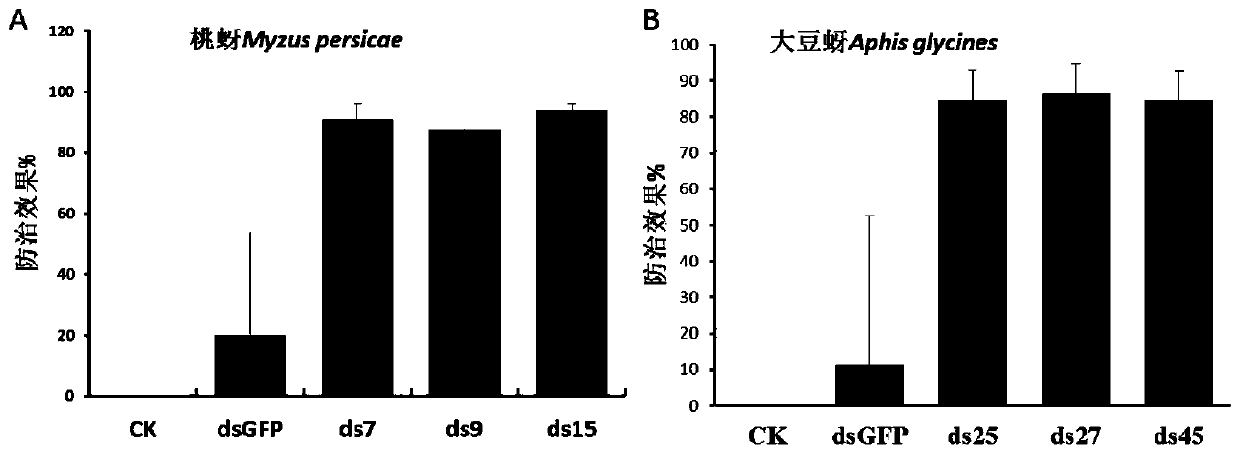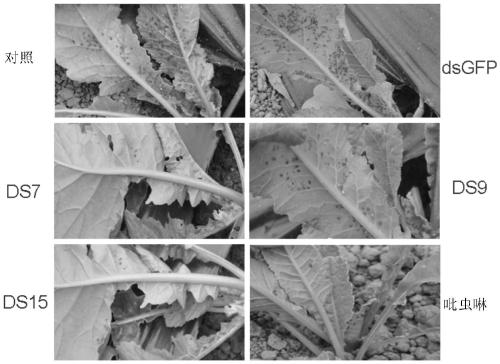RNAi target gene for high efficiency lethality of budworms and application of RNAi target gene
A gene, transgenic plant technology, applied in the fields of biotechnology and agricultural applications, can solve the problems of dsRNA response and target gene silencing efficiency differences, large differences in insect lethal effects, etc.
- Summary
- Abstract
- Description
- Claims
- Application Information
AI Technical Summary
Problems solved by technology
Method used
Image
Examples
Embodiment 1
[0299] Example 1 Synthesis of Target Gene Sequence and dsRNA
[0300] In order to screen effective aphid target genes based on RNA interference technology, transcriptome sequencing was performed on Myzus persicae and soybean aphid (Aphid glycine) respectively (the sampling and sequencing analysis methods of the two aphids were the same). After extracting total RNA from aphids at different developmental stages, equal amounts of RNA were mixed to form the total RNA of the entire developmental stage of aphids, which was sent to Shenzhen Huada Gene Technology Service Co., Ltd. for transcriptome sequencing using the Illumina Hiseq2000 platform. After removing the adapters from the sequencing results, assemble them with the denove program, and then perform functional annotation on Unigene. In this study, target gene fragments were selected from these functionally annotated Unigenes to amplify and synthesize dsRNA. Through a large number of screening, the present invention amplified...
Embodiment 2
[0311] Example 2 Control effect of target gene dsRNA on aphids
[0312] Inoculate a certain number of green peach aphids or soybean aphids on radish seedlings or soybean seedlings respectively, first record the number of aphids inoculated on each plant, and dissolve the synthesized dsRNA into 2% Tween-80, six The dsRNA concentrations of the target genes are shown in Table 3. Then spray 1ml of dsRNA onto the plants inoculated with aphids, and count the next day as the statistical result of the first day after the dsRNA treatment, then count once every other day, count 3 times in total, and record it as after treatment. Day 1, Day 3 and Day 5 results. 2% Tween-80 and dsGFP were used as controls. The statistical results showed that, compared with the control sprayed with only 2% spit-80, the control effects of 3 target genes of peach aphid and 3 target genes of soybean aphid on the two aphids were all more than 80% ( figure 1 , A, B).
[0313] Table 3. Spray concentration of ...
Embodiment 3
[0316] The population reduction rate statistics of the target gene of embodiment 3 to aphids
[0317] Aphids are parthenogenetic insects, born as 1st instar newborn aphids. The period from the first instar newborn aphid to its ability to give birth is about 5-7 days (affected by the ambient temperature). There is an obvious generational alternation phenomenon in aphids on a plant, that is, different generations and various sizes (different ages) Insects are present at the same time, so when the test plants are inoculated there will be various ages of aphids (such as 2th-4th, and possibly adults), so that after each test treatment, the aphids will soon begin to reproduce and produce offspring. One generation, resulting in an increase in the number of aphids on the tested plants after they were counted before spraying. This is a great interference to the judgment of the control effect of aphid insecticides. Therefore, there is a more strict or relatively accurate calculation me...
PUM
 Login to View More
Login to View More Abstract
Description
Claims
Application Information
 Login to View More
Login to View More - R&D
- Intellectual Property
- Life Sciences
- Materials
- Tech Scout
- Unparalleled Data Quality
- Higher Quality Content
- 60% Fewer Hallucinations
Browse by: Latest US Patents, China's latest patents, Technical Efficacy Thesaurus, Application Domain, Technology Topic, Popular Technical Reports.
© 2025 PatSnap. All rights reserved.Legal|Privacy policy|Modern Slavery Act Transparency Statement|Sitemap|About US| Contact US: help@patsnap.com



